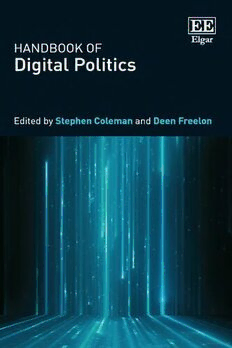Table Of ContentHANDBOOK OF DIGITAL POLITICS
Handbook of Digital Politics
Edited by
Stephen Coleman
Professor of Political Communication, School of Media and
Communication, University of Leeds, UK
Deen Freelon
Assistant Professor, School of Communication, American
University, Washington, DC, USA
Cheltenham, UK • Northampton, MA, USA
© Stephen Coleman and Deen Freelon 2015
All rights reserved. No part of this publication may be reproduced, stored
in a retrieval system or transmitted in any form or by any means, electronic,
mechanical or photocopying, recording, or otherwise without the prior
permission of the publisher.
Published by
Edward Elgar Publishing Limited
The Lypiatts
15 Lansdown Road
Cheltenham
Glos GL50 2JA
UK
Edward Elgar Publishing, Inc.
William Pratt House
9 Dewey Court
Northampton
Massachusetts 01060
USA
A catalogue record for this book
is available from the British Library
Library of Congress Control Number: 2014959459
This book is available electronically in the
Social and Political Science subject collection
DOI 10.4337/9781782548768
ISBN 978 1 78254 875 1 (cased)
ISBN 978 1 78254 876 8 (eBook)
Typeset by Servis Filmsetting Ltd, Stockport, Cheshire
Printed and bound in Great Britain by T.J. International Ltd, Padstow
Contents
List of figures viii
List of tables ix
List of contributors x
1 Introduction: conceptualizing digital politics 1
Stephen Coleman and Deen Freelon
PART I THEORIZING DIGITAL POLITICS
2 The internet as a civic space 17
Peter Dahlgren
3 The social foundations of future digital politics 35
Nick Couldry
4 The Fifth Estate: a rising force of pluralistic accountability 51
William H. Dutton and Elizabeth Dubois
5 Silicon Valley Ideology and class inequality: a virtual poll tax
on digital politics 67
Jen Schradie
PART II GOVERNMENT AND POLICY
6 Online voting advice applications: foci, findings and future of
an emerging research field 87
Fadi Hirzalla and Liesbet van Zoonen
7 Internet voting: the state of the debate 103
Thad Hall
8 Digital campaigning 118
Daniel Kreiss
9 E- petitions 136
Scott Wright
10 Argumentation tools for digital politics: addressing the
challenge of deliberation in democracies 151
Neil Benn
v
vi Handbook of digital politics
PART III COLLECTIVE ACTION AND CIVIC
ENGAGEMENT
11 The logic of connective action: digital media and the
personalization of contentious politics 169
W. Lance Bennett and Alexandra Segerberg
12 Youth civic engagement 199
Chris Wells, Emily Vraga, Kjerstin Thorson, Stephanie Edgerly
and Leticia Bode
13 Internet use and political engagement in youth 221
Yunhwan Kim and Erik Amnå
PART IV POLITICAL TALK
14 Everyday political talk in the Internet- based public sphere 247
Todd Graham
15 Creating spaces for online deliberation 264
Christopher Birchall and Stephen Coleman
16 Computational approaches to online political expression:
rediscovering a ‘science of the social’ 281
Dhavan V. Shah, Kathleen Bartzen Culver, Alexander Hanna,
Timothy Macafee and JungHwan Yang
17 Two- screen politics: evidence, theory and challenges 306
Nick Anstead and Ben O’Loughlin
PART V JOURNALISM
18 From news blogs to news on Twitter: gatewatching and
collaborative news curation 325
Axel Bruns and Tim Highfield
19 Research on the political implications of political
entertainment 340
Michael A. Xenos
20 Journalism, gatekeeping and interactivity 357
Neil Thurman
Contents vii
PART VI INTERNET GOVERNANCE
21 Internet governance, rights and democratic legitimacy 377
Giles Moss
22 Social media surveillance 395
Christian Fuchs
PART VII EXPANDING THE FRONTIERS OF DIGITAL
POLITICS RESEARCH
23 Visibility and visualities: ‘ways of seeing’ politics in the digital
media environment 417
Katy Parry
24 Automated content analysis of online political communication 433
Ross Petchler and Sandra González- Bailón
25 On the cutting edge of Big Data: digital politics research in
the social computing literature 451
Deen Freelon
Index 473
Figures
6.1 Advice of the Dutch Stemwijzer, the oldest and relatively
most popular VAA 91
10.1 A series of screenshots from the PolicyCommons Argument
Visualization Tool showing Issue Map and Argument
Network styles of visualization 155
11.1 Elements of collective and connective action networks 188
12.1 Voter turnout in American presidential elections,
1972–2012 (by age) 207
16.1 Proportional volume of keyword use for Sandra Fluke and
Trayvon Martin cases 291
16.2 Proportional volume of hashtag clusters for Sandra Fluke
case 295
16.3 Proportional volume of hashtag clusters for Trayvon
Martin case 296
16.4 Retweet network for Sandra Fluke case with major
hashtags 298
16.5 Retweet network for Trayvon Martin case with major
hashtags 299
17.1 Percentage of people who use their mobile phones while
watching television in the United States 317
18.1 Australian Twitter News Index (ATNIX), showing tweets
per week linking to key Australian news sites, June 2012 to
December 2014 334
20.1 Source, media and audience channels in the gatekeeping
process 368
viii
Tables
4.1 Examples of potentially effective forms of Fifth Estate
networking 55
4.2 A categorization of networked institutions and individuals 58
13.1 Results of a 4 (citizenship orientation) x 2 (gender)
MANOVA examining differences on measures used in the
cluster analysis (z- scores) 233
13.2 Results of a 4 (citizenship orientation) x 2 (gender)
MANOVA examining citizenship orientation group
differences on measures of citizenship competences
(z- scores) 234
13.3 Zero- order correlations between political engagement and
Internet use 235
13.4 Results of ANCOVAs examining citizenship orientation
group differences on measures of Internet use 237
16.1 Follower and following counts at level 1 and 2 of collection 288
16.2 Principal component analysis of hashtag use in Sandra
Fluke case 293
16.3 Principal component analysis of hashtag use in Trayvon
Martin case 293
22.1 Qualities of Internet surveillance 399
25.1 The methods of 40 highly cited social computing research
papers 455
ix

